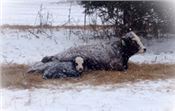|
As Temperatures Drop, Keep Livestock Fed And Dry

Given the chance to grow their winter coats and extra nutrition, most livestock will feel perfectly
comfortable in colder conditions.
Division of Agriculture photo
LITTLE ROCK, ARK.
As it is want to do, winter weather rolled into Arkansas last week with little concern for holiday pleasantries. On the first day of December, Arkansans throughout the state awoke to temperatures in the 20s. While things did warm briefly throughout the week, the rains that followed only sharpened the misery.
While most of the state’s major commodities finished harvest by November’s end, livestock producers continue to manage herds throughout the winter. And while the cold temperatures can certainly make things uncomfortable for the humans involved, livestock experts with the University of Arkansas System Division of Agriculture say that as long as they’re well-fed and dry, cattle, horses and other livestock should be just fine.
Naturally protected for winter
“When it feels really cold to us outside, that cow with the extra hair coat may actually be fairly comfortable,” Shane Gadberry, professor of ruminant nutrition for the Division of Agriculture, said. “If you take a cow with a winter hair coat, and it’s 32 degrees outside, as long as that coat is dry, she’s still on the more comfortable side, and probably eating a little more hay to take care of the extra energy she is burning.”
Gadberry said that cattle generally have two compensating mechanisms that kick into gear when the temperature drops: Adding on a heavier hair coat and stored body fat.
“That’s an extra layer of insulation,” he said. “On the cold days, we see cows increase their forage intake. Producers may notice their cows just eat a whole lot more hay over a cold wet winter, one year over another.”
Gadberry said that much of the managed cattle in Arkansas are derived in part from English breeds, such as Angus and Hereford, which are naturally well-adapted to colder climates. Breeds that are tropically adapted tend not to grow a heavy winter hair coat, he said, and herd managers should be mindful of the vulnerability.
Calories to keep warm
Similar to cows, horses will also produce a heavier hair coat in the winter and do their best to keep the cold at bay through caloric intake. Mark Russell, an associate professor of equine science for the Division of Agriculture, said the best thing horse owners can do is make sure the animals have access to lots of high-nutrient hay.
“As long as they have hay in front of them all the time when it gets below freezing, that’s the best thing you can do for them – keep their stomachs full,” Russell said. “That offers more warmth than almost anything, really, whether that’s a round bale outside or a small bale in a stall.”
Russell said that some horse owners place blankets on their horses with the mistaken notion that it aids the animal’s natural coat.
“A lot of people put blankets on their horses with the best of intentions,” he said. “And that’s fine, if you’re trying to keep their coats short and slick for a show. But if they’ve grown a winter hair coat, that is their blanket. They don’t need another one.
“A blanket actually pushes down a winter hair coat and won’t allow the hair to do it’s intended job,” Russell said.
Additionally, a blanket can be a liability for the animal if there’s rain in the forecast.
“If the blanket gets wet, they’re worse off,” he said. “They’re colder and may get sick.”
Whichever way the wind blows
Similarly, rain, snow or mud can stymie the insulating properties of cattle coats. While moving entire herds of cattle indoors isn’t an option for most ranchers, Gadberry said their best approach is to relocate feeding sites to minimize wind exposure.
“If you’re already cold and wet, wind is going to make it that much worse,” he said. “So if you’ve got a wind coming out of the west, and a tree line near the western edge of your farm, move the hay closer to that tree line.”
Finally, livestock managers should make sure their animals have access to plenty of water.
“A cow that’s not drinking water isn’t going to be eating much hay,” he said. If temperatures are at or below freezing, producers need to be checking water tanks and ponds; if the edges or surfaces are frozen, the ice needs to be broken, so that cattle can drink freely.
Hay testing
A fundamental strategy for successfully caring for livestock through the winter is ensuring they have access to high-quality, nutritionally dense hay, Gadberry said.
“Work with your county extension agent to have your hay supply tested for its nutritional value,” he said. “Make sure it’s nutritionally adequate to take care of your cows, especially if they’re within a few months of calving or lactating.
“Once that inclement weather sets in, you’ll have a good foundation to understand how much supplemental feed a cow needs to get through that period,” he said. ∆
|
|